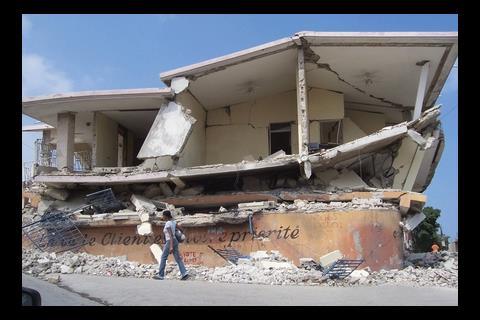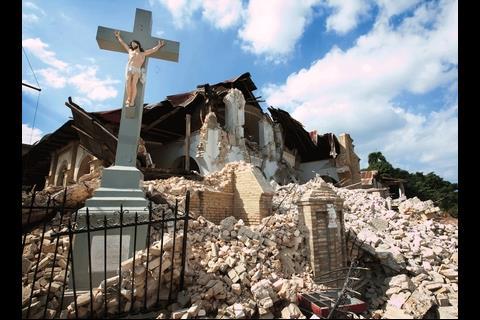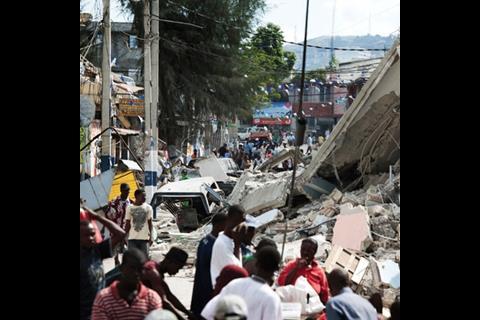Roxane McMeeken reports on the reconstruction effort in Haiti, amid growing fears that the ad hoc approach to rebuilding could be doing as much harm as good
Gerri Mulder’s colleagues in London have nicknamed him Indiana Jones. Every day Mulder blags his way into Haiti across its border with the Dominican Republic in a van with the letters “UN” emblazoned upon it. Mulder is not a UN employee.
It’s a risky business, crossing this border – fraught with the possibility of being required to pay bribes, being robbed or even kidnapped – and claiming to be from the UN provides scant protection. But this is the ad hoc way in which much of the aid work in Haiti in having to be conducted.
When Mulder, who is a consultant for London-based Cavendish Engineers, enters the country, he brings urgently required water and tarpaulins. Recently he built a pump for a well in the capital Port-au-Prince. This simple device now provides water to about 16,000 people.
Back in London, Cavendish’s managing director Steve Allen says it had no choice but to build the pump independently: “How do you turn up and build something like that? You simply pay someone to turn a blind eye – this is the Third World and there’s just been an earthquake. Did we do the right thing? Those 16,000 people would not be alive now otherwise. We’re not doing much, but we are keeping them alive.”
Haiti is at a critical juncture because reconstruction is about to take place. Previous post-disaster reconstruction efforts, such as after the 2004 South-east Asian tsunami, show that it is at this point that things can go badly awry. What happens now will have repercussions long into the future for how children are educated, how businesses recover, and how structures cope with any future disasters.
As crucial as the efforts of Cavendish and other organisations are, they and other UK construction professionals are arguing that the ad hoc approach to recovery must be replaced by something better – and quickly.
Allen says: “We can’t do much more with our limited funds – we’ve been round everyone we know raising money. It’s now down to the government and the big agencies to rebuild Haiti.” But fears are growing that this just isn’t happening in a co-ordinated way.
The dangers of rushing in
The 7.0 magnitude earthquake that struck Haiti in mid-January was one of the worst natural disasters to hit a community in living memory. More than 200,000 people were killed and about 1.2 million were left homeless and are now living in tents and lean-tos made with tarpaulin provided by the UN and international relief agencies. The UN estimates $11.5bn must be spent on reconstruction in Haiti over 10 years.
The devastation was largely due to the poor quality of buildings, which caused so many to collapse. Charity Build Aid, which sent a team to evaluate the state of Haiti’s building stock in March, in its initial report on the trip blamed “an absence of an engineered structural design, poor quality primary materials and workmanship” in the vast majority of buildings.
Robert Muir, trustee and technical co-ordinator with Build Aid, who co-wrote the report, says he is worried the same mistakes will be repeated when rebuilding takes place. He says: “There is a real danger reconstruction could start in earnest without having been properly considered.”
Understandably, there is immense pressure from the local people for rebuilding to start. “The displaced population are living in shelters, their children aren’t going to school and they are relying on aid agencies, so they want desperately to get back to something a bit more like normality,” says Muir.
Despite this, he says, it would be a huge mistake for both local people and the myriad non-governmental organisations (NGOs) to rush into rebuilding without a coherent, nationwide strategy in place. “A unified plan is required that includes all the stakeholders, including the UN, World Bank, RICS, aid agencies, and crucially, the Haitian people.”
The plan must set out a programme for recovery and a building code to ensure new structures are resistant to seismic activity and the other natural disasters to which Haiti is susceptible, particularly hurricanes. Muir argues that there must be a “moratorium on all but essential lifeline buildings” until the plan is in place.
The dangers of not having a plan are highlighted in the report Lessons from Aceh, by Jo da Silva, director of international development at Arup. In her report on rebuilding in Indonesia after the tsunami in 2004, she warns that a lack of co-ordination and the failure to agree and disseminate building standards hindered Aceh’s recovery. Da Silva says that in the first six months there was confusion and no clear policy over the type of shelter assistance required. She says: “Everyone began building houses immediately, when their efforts might have been better spent using the post-disaster window of opportunity to build the capacity of the construction sector through vocational training programmes, establishing manufacturing plants for building components or establishing information resource centres.”
Rushing in to rebuilding, although understandable, can be disastrous. Da Silva says that some rebuilding work in Aceh had to be redone. “Agencies who had already constructed ‘semi-permanent’ houses were faced with having to upgrade or replace housing.” A key reason for this was that housing was built to withstand tsunamis without taking account of the area’s extreme vulnerability to seismic movements.
In Haiti, da Silva says the situation is reversed. “We are already seeing people thinking only about seismic risks when in fact hurricanes are a huge problem for Haiti, so new buildings must factor this in.”
Robert Hodgson, interim country director for Haiti at charity RedR, which is providing training to aid agencies in Haiti in partnership with charity Bioforce, also warns there is a high risk that poor building techniques and inappropriate materials will be used. For example: “NGOs have a history of getting the wrong timber because they’ll order the right type of wood without specifying the grade they need, which means the suppliers send them low-quality offcuts.”
Worrying signs
But the unified approach that the likes of da Silva and Muir are calling for has yet to emerge. The Haitian government has written the National Action Plan for Reconstruction to guide recovery and development in tandem with the UN and various experts. Under the plan an Interim Haiti Reconstruction Commission would channel nearly $4bn into building projects during the next 18 months. UN secretary-general Ban Ki-moon, writing about the plan on 28 March on the UN website, said: “If Haiti is to flourish, social infrastructure and economic development must be dispersed from Port-au-Prince to regions and cities throughout the country. That is why Haiti’s national plan contains ample provision for environmental recovery, land reform, and new investment in fisheries and agriculture.”
The plan is a good start but it sets out high-level aims, like identifying areas for development away from Port-au-Prince in order to decentralise the population and economic centres, establishing large work sites from where the electrification of the country and the creation of a national transport system will be developed. But the plan does not answer the call from experts like Build Aid for detailed guidance and a controlled approach to construction.
Meanwhile, building work is already happening. Hodgson at RedR was in Port-au-Prince in April, and he warns that local people are already rebuilding houses that will not be sufficiently resistant to seismic activities. His message is that, like the NGOs, local people need clear information immediately on how they should be rebuilding. “I saw one self-build timber frame house with a pitched roof under construction and it did not look like it was going to last – it didn’t have enough rafters.” It’s easy to see why: “The temptation to cut corners is huge when money and resources are limited, and now that the hurricane season is on the way.”
What must happen now
Haiti is in dire need of a unified rebuilding strategy that is both detailed and widely disseminated. Those advocating this say it must come from the UN Shelter Cluster, which is overseeing the relief effort in Haiti.
The RICS Disaster Management Commission is among those advocating a building code. Shailesh Kataria, director of the commission, says it must fit the limited resources available for enforcing it as well as the materials available. He says a campaign would be needed to raise public awareness of the code and it would need to reach people who are unable to read. “It could be a poster campaign based on clear images,” he says.
Muir says the strategy should include a plan for assessing damage to existing buildings, demolishing unsafe buildings and ensuring new buildings are designed by engineers to specific standards (see box, page 45). Da Silva says new buildings must take account of Haiti’s vulnerability to hurricanes as well as earthquakes, which means lightweight structures, including roofs, to prevent heavy loads falling due to seismic events, but roofs firmly anchored to avoid being blown off in high winds. Da Silva adds that the new models must also be designed by looking at how locals build and developing ways to modify this to make buildings significantly safer. All this should happen as soon as possible – the opportunity to ensure that Haiti never again suffers a disaster on this scale is already passing.
The scale of the task
- In the worst affected area, the capital city Port-au-Prince, only 10% of buildings have no visible damage.
- 2,500 schools were damaged or destroyed, as well as hospitals and businesses.
- Nearly all government buildings were destroyed.
- At least 160,000 new homes are required.
- Rebuilding programme could take up to 30 years.
- The majority of the Haitians who would have been able to manage building work, including government officials and skilled workers died in the earthquake.
- Before rebuilding starts, rubble from collapsed buildings must be cleared and unsafe buildings must be identified and demolished.
- Haiti lacks equipment needed for these tasks and damage to the docks is hindering bringing it in.
- There is no detailed clearing and demolition plan for Haiti at present, although it is mentioned in broad terms in the National Action Plan for Reconstruction.
- There is no agreement yet on where waste material cleared could be stored or whether it could be used for other purposes.
Build Aid’s recommendations
- Inspect the whole building stock and retrofit suitable buildings to help them withstand further natural disasters – hurricanes and floods as well as earthquakes
- Delay reconstruction until suitable controls are in place for the government to regulate and enforce standards for all work
- Build hybrid housing that is between temporary and permanent, that is, housing that would last 20 years as opposed to 50. Robert Muir says: “Transitional housing can be built quicker than fully permanent housing but it will get people to a regularised state.”
- Consider using alternative technologies better suited to the geological and meteorological conditions in Haiti, including steel and timber frame, well anchored structures, pre-fabricated and composite structures
- Buildings must be designed by qualified engineers, not unqualified locals or members of NGOs
- Train Haitians in how to build safely and in manufacturing and installing new products
- Devise a national programme for rebuilding in consultation with all stakeholders.
Resources:
- Lessons From Aceh is available at www.arup.com/publications/lessons_from_aceh.aspx
- Find out more about Build Aid and RedR at www.buildaid.org.uk and www.redr.org.uk
- Oxford Brookes University runs various courses in disaster recovery work. Visit www.brookes.ac.uk
What can be repaired?
There are four main types of building in Haiti, which withstood the earthquake to varying degrees:
- Timber and corrugated galvanised iron (CGI) walls and roof - Mostly unaffected by the earthquake as they can rattle about with little impact.
- Unreinforced hollow block masonry with timber and CGI roof - Suffered damage, typically to walls and openings, which lacked lintel and band beams, but relatively easy to repair as they are single-storey buildings and parts can be removed and replaced easily.
- Concrete columns, unreinforced hollow masonry block infill with timber and CGI roof - Heavily affected owing to poor quality workmanship (especially on concrete elements), unreinforced walls and openings, and greater numbers of windows and doors, which weakened the buildings. Single-storey structure means they are relatively easy to repair and improve.
- Stone masonry buildings - Very heavily affected as wall leafs separated and fell apart because through stones had not been used. Use of uncut stone (as opposed to stone cut to fit) and lack of band beams meant stones fell out of walls easily. Many of these structures have been reduced to rubble.
Source: Kubilay Hicyilmaz, Arup
View from the ground
Architect John McAslan has just returned from Haiti, where he is working on plans to restore historic buildings.
“You look around Port-au-Prince and think, my God, this whole place has been destroyed. The downtown area is rubble and there is very little evidence of reconstruction taking place. Things are a lot better in the countryside, which is encouraging.
“Still, there are half-a-million people living with ‘host families’ and at least another half-a-million living in about 1,000 camps. These are operating in a fairly civilised way – people are opening shops and markets are springing up. But the rainy season will start in June and life will become a nightmare for anyone still in a camp. When I was there, there was an incredible storm. It only lasted three hours but it still flooded the camps and streets.
“The immediate challenge is to get people into transitional housing as soon as possible and so far the effort to organise that looks rather sporadic.
“We are working with various groups to assess which historic buildings should be repaired. We’re aiming to produce a list of mid-19th century and late 19th/early 20th century buildings, which will probably include some houses, a university building, school, bank and mercantile buildings, as well as some of the ‘gingerbread homes’ [houses from the late 1800s with intricate latticework and fretted wood]. We’re also working on a design for the rebuilding of the iron market in Port-au-Prince.”
Postscript
Photography by David Levene
































No comments yet